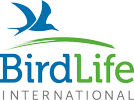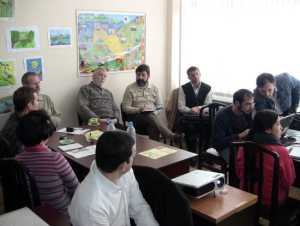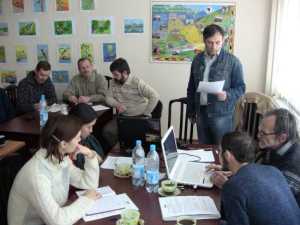

THE PROTECTION OF BIRDS

 |  | THE PROTECTION OF BIRDS |  |

The meeting was jointly organized by Uzbekistan Society for the Protection of Birds (UzSPB) and Wetlands International to promote the International Waterbird Census in Uzbekistan. It took place from 4-6 March 2011 in Tashkent and gathered in total 20 participants, representing the state organization, scientific institute, University, NGOs and mass-media from Tashkent, Samarkand, Bukhara and Moscow. The workshop included one and half session day and one day of field excursion.
Main tasks of the workshop were as followed:
1. Extend scope of the IWC in Uzbekistan with covering the priority sites;
2. Promote collaboration and exchange of information between scientists, NGOs and governmental agencies with regards to waterbird monitoring and conservation in Uzbekistan;
3. Improve the availability and quality of IWC data from Uzbekistan for Wetlands International database.
Prof. Oleg Mitropolsky has opened the workshop on behalf of UzSPB. In particularly, he pointed out the importance of waterbird monitoring not only in winter season, but also in breading and migration periods. The morning session of the workshop on Friday 4 March included general presentations about status and results of waterbird monitoring in Uzbekistan and Central Asia, as well as about cooperation with AEWA. Dr. Alexander Solokha gave overview of waterbird monitoring in Central Asia. Dr. Yevgenia Lanovenko reported about the history of waterbird monitoring in Uzbekistan and how this results were being used for biodiversity conservation. Ms. Anna Ten continued this topic with more details about results of recent surveys and particularly about involvement of students and other volunteers under the UzSPB framework. Mr. Maxim Mitropolsky as the official representative, reported about the importance of waterbird monitoring data for planning and implementing the conservation actions in Uzbekistan. He listed the Ramsar, IBAs and protected areas which were identified by waterbird criteria. Some other sites still need to be nominated as the Ramsar site or nature sanctuaries. State Committee leads in this development in collaboration with Academic institutions, Universities and NGOs. Then Mr. Mitropolsky gave his second presentation about implementing of AEWA in Uzbekistan. As a party since 2003, Uzbekistan is involved in international activities on protection of migratory waterbirds and their habitats.

The afternoon session started with provincial reports from Bukhara, Samarkand and Tashkent. In the last years the UzSPB coordinates the mid-winter waterbird counting in these regions through its network of student's birdwatching clubs and teachers of local Universities. Field surveys were organized mostly at voluntary base. Available data suggest the decline in wintering population of the Coot, Pygmy Cormorant and White-headed Duck, that can be due to mass mortality during extreme cold winter of 2007/2008. The session was finalized by discussion of issues and opportunities for promoting the IWC in Uzbekistan. Mr. Georgy Narmin from Uzbek Hunters Association identified poor awareness of hunters as main problem for protection of endangered species and involvement of hunting managers into monitoring. He also noted that his Association supported waterbird monitoring but only in autumn and spring due to limited capacities. The workshop recommended for the Committee, Institute of Zoology and UzSPB to increase production of awareness materials for hunters such as the posters, brochures and basic field guides.
Much attention has been paid to the discussion about coordination and cooperation in waterbird monitoring. The main issues identified were lack of funds for mid-winter counts, poor coordination and collaboration, hard access to important Aidar-Arnasay wetands resulting in lack of data from there, and timely submitting IWC data to Wetlands International. Participants proposed an agreement to be concluded between the Committee, the Academy of Sciences and UzSPB about planning and coordination of field surveys, as well as sharing and use of IWC data. The Committee can provide more support for the next IWC under the budget for monitoring of lowland wetlands. Also it was decided to collate the IWC 2011 data and publish them in Ecological bulletin of Uzbekistan (the Committee to coordinate this) for securing interests of individual experts. Dr. Roman Kashkarov suggested that this would be the special issue of the Bulletin to report about winter surveys. All these measures should contribute to the larger scope and sustainability of IWC in Uzbekistan.

On Saturday, 5 March the agenda included two Ramsar related presentations and training. Dr. Sergey Zagrebin reported about implementing of Ramsar Convention in Uzbekistan and particularly about community involvement into wetland conservation. Second presentation by Alexander Filatov and Maxim Mitropolsky was about plans for establishment of third Ramsar site in Uzbekistan - Tudakul and Kuymazar reservoirs, Bukhara region, which are also the key IWC sites. Training on the use of Excel program for maintaining and presentation of the IWC data was the last session agenda. Alexander Solokha demonstrated the Wetlands International IWC spreadsheets and instructed the participants how to fill them in for further maintaining and submitting to Wetlands International. All necessary guidelines are available in Russia. This brief training was especially useful for new IWC provincial and national coordinators, as well as for those interesting in treatment of data and preparation of IWC review.
On Sunday, 6 March the participants carried out a full-day trip to Tuyabuguz reservoir, 40 km NE of Tashkent, which was the IWC site supporting numerous wintering and staging waterbirds. During excursion the waterbirds concentrations were spotted on the eastern shore of reservoir. Altogether we found 15 species of waterbirds, and Mallard and Pintail were the most abundant. Students and junior researchers trained at waterbird identification and counting with the assistance by lead experts.
| Webmaster Ernest Khurshut: uznix@narod.ru | Fishes of Uzbekistan Last modified: 04.04.2021 |